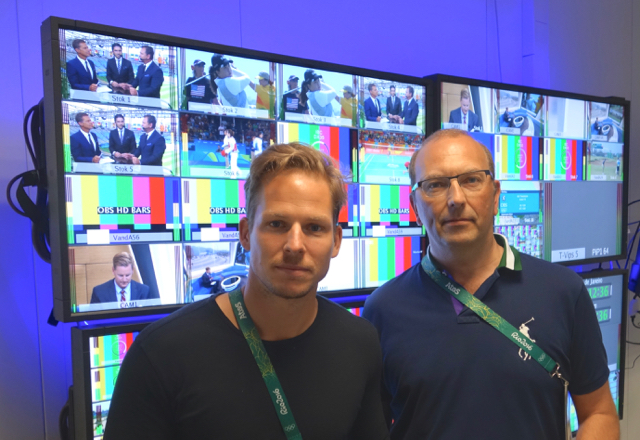Live from Rio 2016: Viasat, NEP Sweden Embrace Flexibility
Viasat Sweden’s presence in Rio includes 80 people, with nearly 30 of them reporters and talent. “Overall everything went well although some of our athletes did not do as well as we hoped,” says Joakim Ekstrand, Viasat Sweden, Olympics, production manager.

Joakim Ekstrand, Viasat Sweden, Olympics, production manager (left) and Mikael Krantz, NEP Sweden, technical producer, makes sure Sweden Olympic fans see their favorite athletes compete.
Mikael Krantz, NEP Sweden, technical producer, is on hand overseeing the technical operations (NEP Sweden is providing the technical facilities) that make use of the OBS VANDA+ package that provides 55 event and camera feed to the Viasat team on site at the IBC. The team is also taking the OBS Multichannel Distribution Service (MDS) and converting it to 50 Hz prior to sending it to Stockholm.
The Viasat facility at the IBC is connected to Viasat in Stockholm via five 1 Gbps circuits that provide 12 video circuits with MADI audio that use Nimbra J2K encoders for transport. One of the circuits is also used to backhaul the Olympic Ultra HD service.
“The rest of the bandwidth is aggregated and used for file transfer for editors and a number of Nevion encoders/decoders are also in use to move content around,” says Krantz. “There are also some dedicated lines so they can choose feeds and extra material. And the MDS is also sent via satellite as a backup or primary signal, depending on the sport.”
Operations at the IBC are basically operating as master control, making sure that signals are in the best technical shape possible (audio mixing, fixing latency issues) before heading to Stockholm where two live studios and control rooms pull together the content. There are also editors on site working with Adobe Premier.
While some of the Swedish athletes did not manage to meet expectations one group did: the women’s football team which lost to Germany in the final but managed to knock off the United States and Brazil along the way. It’s those sort of unforeseen successes that can also make use of contingency plans.
“It’s hard to plan for things like that when you need to book things two years prior to the Olympics so we tried to design our set up so that it could be extremely flexible and that was proven out here as we had no plans to need a studio at Maracana Stadium [where the final was held],” says Krantz. “For example, at the women’s football final we set up a full studio in a day as before the Olympics we had identified a few spots where we might need a point of presence. So we booked fibers to those spots and had mobile kits that could go there. Then we have adjusted the resources as the tournament evolves to put those kits where the focus is at the moment.”
Krantz says the system allows total production flexibility.
“The savings compared to the old way of doing things, are huge,’ he says.
